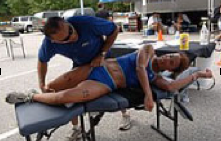Imagine you find a way to spend less time suffering from pain and enjoying what you want to love. Yes, when you are in pain, you want to take control of pain at any cost. Are you one of those who suffer similar kind of situations:
- Are you hostage of your body's limitations?
- Do you want more freedom and want to move without pain?
- Do you want to reclaim your vitality?
If the answer is yes, then you need to prepare yourself for the physical wellness journey.
In a world where daily grind and sometimes sedentary lifestyles can lead us to take action. We may go to the gym or do family motion activities to keep us healthy. These grinds can often result in nagging aches and stubborn knots.
It is where Active Release Therapy Technique (ART) proves to be a game changer for pain relief and improved performance. This post will explore the incredible benefits of ART and its secrets and various uses.
If you are searching for active release therapy near me? Don't wait any longer! Explore our services at 1st Choice Sports Rehab and take the first step towards pain relief and improved mobility.

What is the active release technique?
The active release therapy technique is often abbreviated as ART. It is a specialized and highly effective manual therapy approach to diagnose and treat musculoskeletal and soft tissue conditions. A chiropractor, Dr. P. Michael Leahy, developed this technique, primarily used by most healthcare professionals today.
ART identifies, isolates, and targets affected areas to break up the scar tissue. It promotes the blood flow and improves the healing process. Doctors use this technique to treat the following problems:
- Tendons
- Nerves
- Muscles
- Ligaments
The ART practitioner uses their hands to locate these specific adhesions or "trigger points" within the affected soft tissues. Then, they apply precise tension and movement to break down the adhesions. This hands-on approach is both highly targeted and customizable for addressing a wide array of conditions.
What body parts are treated?
Several areas in ART can be used to treat pain and symptoms:
Fascia: Fascia is a fibrous connection of tissue that is a protective and supportive layer for muscles and organs throughout your body. Inflammation within a fascia band can result in severe pain and stiffness. An example of a common fascia-related condition is plantar fasciitis.
Major muscle groups: Your major muscle groups are susceptible to strains and pulls caused by overuse or trauma. These muscle groups encompass areas such as your neck and shoulders, back, and hamstrings.
Tendons and ligaments: Tendons connect muscles and bone, and ligaments connect muscles and bone. Injury to either of these structures can lead to reduced range of motion and pain.
- Demonstrative Pronoun
- Conjunction
- Relative Pronoun
- Adverb
What conditions are treated?
- Shin splints
- Sciatic nerve pain
- Plantar fasciitis
- Bursitis
- Tennis elbow
- Lower back pain
- Chronic neck pain
- Tension headaches
- Shoulder strains, including frozen shoulder
- Carpal tunnel syndrome
How does the active release technique work?
Active-release therapy is a specialized manual technique for treating soft tissue injuries and musculoskeletal conditions. It targets adhesions, scar tissues, and muscle imbalances that may contribute to pain. Here is how it works:
Evaluation: A certified ART practitioner assesses the patient's movement patterns and identifies any areas of pain or dysfunction. It helps them understand the specific pain points or the areas that may be affected.
Hands-on Treatment: The practitioner uses their hands to apply precise tension and pressure to the affected tissues. They use a combination of specific movements and pressure to locate and target the problematic areas.
Tissue Release: The practitioner applies tension to the affected tissue while guiding the patient through specific movements using their hands. This combination of pressure and movement helps break up adhesions and restrictions in the affected soft tissues.
Active Participation: ART involves active participation from the patient, unlike some passive therapies. Patients are typically instructed to perform specific movements or contractions while the practitioner applies tension to the targeted area. Their active involvement helps to restore proper movement patterns and enhance the effectiveness of the treatment.
Restoring Function: The tissues regain flexibility and strength after releasing adhesions and restrictions. It ultimately helps to restore proper function and improve overall performance.
Benefits of active release technique
ART offers many benefits for someone suffering from pain and some suffering from tissue injuries from sports, overuse, or trauma.
- Management of carpal tunnel
- Management of shin splints
- Management of plantar fasciitis
- Management of tennis elbow
- Improvement of sciatic symptoms
- Increased flexibility
- Increased range of motion
- Decreased lower back pain
- Improved chronic neck pain
- Relief of tension headaches
What can You expect from the active release technique?
Active Release Technique involves very accurate pressure and can sometimes be very painful. If you have low pain tolerance, you may find the session uncomfortable.
For some people, it can be performed in one session, but some may require more than one session. Remember that only a certified ART professional should perform it. If you are looking for an active release therapy near you, connect with 1st Choice Sports Rehab.
Conclusion
ART is an effective treatment for various injuries caused by soft tissues. It can help reduce pain, restore motion, and return to everyday life.


No comments yet